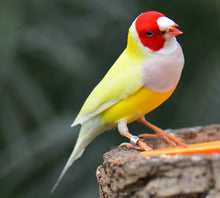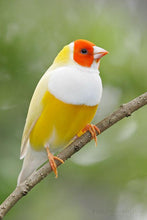The Gouldian Finch, Erythrura gouldiae, is also called as the Gould’s Finch or Lady Gouldian Finch.
Distribution: These beautiful and impressive little finches have their origins in Australia and are dissipated from the Cape York Peninsula through the Northern Territory and north-west Queensland to the Kimberley region of West Australia.
Description: Gouldian Finches are 130 mm to 140 mm in length. Both males and females are found in bright colors of black, yellow, green, red and other colors. The color of the beak is fleshy overall but when the adults are in breeding condition the tip of the beaks turns orangish, reddish, or blackish.
The color of the female is less bright compared to males. Moreover, the chest of the male is purple while the chest of the female is a lighter mauve.
The heads of the Gouldian Finches may be black, red, or yellow. Earlier, people use to think that there are three kinds of finches but later people came to know that there are different colors of finches. The color of the breast and body has also changed due to selective breeding (yellow, blue and silver instead of green back).
Juveniles feature unique colors. Their sides, heads, and necks are grey in color while their wings, backs and tail feathers have olive green color. Their undersides feature pale brown color. The beaks are black with a red tip. The color of the feet and legs are light brown.
Newly hatched Gouldian finches are naked and pink-colored for about 12 days when the feathers begin to appear. Very young birds also feature bluish shiny structures on their beak sides which enable the parents to detect them even in the dark.
Additional Information: Gouldians are softer and more responsive to differences in temperatures and are vulnerable to airsack mites. If your Gouldian experiences respiratory problems, this must be the first thing to check.
Besides this, the Gouldian finches lack parenting skills. Most of the breeders have society or zebra finches for rearing the Gouldian finch chicks/eggs in order to increase the rate of survival.
Diet / Feeding: Captive Diet: Paradise Earth Premium Finch Blend as well as soft foods, fresh water every day, a cuttlebone, as well as vitamins. The blue-blacked variety cannot produce their own vitamin A; and therefore, they especially need vitamins in their soft food. Grit and cuttlebone are an important component of a finches’ diet






